Biomimetic Modular Honeycomb with Enhanced Crushing Strength and Flexible Customizability
Abstract
1. Introduction
2. Modular Biomimetic Honeycomb Design
2.1. Geometric Model
2.2. Relative Density
3. Finite Element Models
4. In-Plane Dynamic Crushing Behaviors
4.1. Low-Velocity Crushing
4.1.1. Deformation Mode under Low-Velocity Crushing
4.1.2. The Dynamic Crushing Strength under Low-Velocity Crushing
4.1.3. Generalized Scenario
4.2. High-Velocity Crushing
4.2.1. Deformation Mode under High-Velocity Crushing
4.2.2. The Dynamic Crushing Strength under High-Velocity Crushing
5. Discussion
5.1. Densification Strain
5.2. Energy Absorption
5.3. Customized Strategies for Uniaxial Compression
5.4. Customized Strategies for Biaxial Compression
6. Conclusions
- Biomimetic Design: Drawing inspiration from the natural density variation observed in tree trunks, this work effectively integrates this concept into the honeycomb structure design. The novel honeycomb features a bio-inspired modular design, where the walls of the sub-honeycombs in a conventional honeycomb are selectively thickened. Utilizing the formula for calculating the relative density of porous structures, a method for calculating the relative density of modular honeycombs is provided.
- Reinforcement Mechanisms: Across a range of impact velocities, the densification strain in modular honeycombs remains comparable to that of traditional honeycombs with similar relative densities. Nonetheless, increasing the cell wall thickness augments the plateau stress of modular honeycombs during low-velocity impacts, thereby enhancing their energy absorption capability. At a strain of 0.85, the energy absorption capacity of modular honeycomb can be enhanced by up to 36.68% and 25.47% compared to conventional honeycomb at velocities of 1 m/s and 10 m/s, respectively. Nearly identical densification strains coupled with increased plateau stresses constitute the principal mechanism that supports the superior energy absorption capabilities of modular honeycombs.
- Flexible customizability: Under low-velocity impacts, modular honeycombs display distinctive deformation modes, which are modifiable through adjustments in the sub-honeycomb configurations, making them different from traditional honeycombs. Conversely, at high velocities, the deformation mode in modular honeycombs mirrors that of traditional ones, marked by a densification that propagates from the impact end to the fixed end. Inspired by the deformation mechanisms observed during low-velocity impacts, it is possible and practical to design a modular honeycomb that exhibits a multi-stage mechanical response. This can be achieved by meticulously adjusting the arrangement and wall thickness of the sub-honeycombs, thereby devising their distinct deformation modes under both uniaxial and biaxial compression.
Author Contributions
Funding
Institutional Review Board Statement
Informed Consent Statement
Data Availability Statement
Conflicts of Interest
References
- Qi, C.; Jiang, F.; Yang, S. Advanced honeycomb designs for improving mechanical properties: A review. Compos. Part B Eng. 2021, 227, 109393. [Google Scholar] [CrossRef]
- Costanza, G.; Solaiyappan, D.; Tata, M.E. Properties, applications and recent developments of cellular solid materials: A review. Materials 2023, 16, 7076. [Google Scholar] [CrossRef] [PubMed]
- Yeo, S.J.; Oh, M.J.; Yoo, P.J. Structurally controlled cellular architectures for high-performance ultra-lightweight materials. Adv. Mater. 2019, 31, 1803670. [Google Scholar] [CrossRef]
- San Ha, N.; Pham, T.M.; Tran, T.T.; Hao, H.; Lu, G. Mechanical properties and energy absorption of bio-inspired hierarchical circular honeycomb. Compos. Part B Eng. 2022, 236, 109818. [Google Scholar]
- San Ha, N.; Lu, G. A review of recent research on bio-inspired structures and materials for energy absorption applications. Compos. Part B Eng. 2020, 181, 107496. [Google Scholar]
- Sun, G.; Chen, D.; Zhu, G.; Li, Q. Lightweight hybrid materials and structures for energy absorption: A state-of-the-art review and outlook. Thin-Walled Struct. 2022, 172, 108760. [Google Scholar] [CrossRef]
- Tarlochan, F. Sandwich structures for energy absorption applications: A review. Materials 2021, 14, 4731. [Google Scholar] [CrossRef]
- Haq, A.U.; Reddy, N.S.K. A brief review on various high energy absorbing materials. Mater. Today Proc. 2021, 38, 3198–3204. [Google Scholar] [CrossRef]
- Ganilova, O.A.; Low, J.J. Application of smart honeycomb structures for automotive passive safety. Proc. Inst. Mech. Eng. Part D J. Automob. Eng. 2018, 232, 797–811. [Google Scholar] [CrossRef]
- Zinno, A.; Prota, A.; Di Maio, E.; Bakis, C. Experimental characterization of phenolic-impregnated honeycomb sandwich structures for transportation vehicles. Compos. Struct. 2011, 93, 2910–2924. [Google Scholar] [CrossRef]
- Shideler, J.L.; Swegle, A.R.; Fields, R.A. Honeycomb sandwich structure for future space transportation systemswith integral cryogenic tankage. J. Spacecr. Rocket. 1984, 21, 246–252. [Google Scholar] [CrossRef]
- Ye, T.; Li, L.; Guo, P.; Xiao, G.; Chen, Z. Effect of aging treatment on the microstructure and flow behavior of 6063 aluminum alloy compressed over a wide range of strain rate. Int. J. Impact Eng. 2016, 90, 72–80. [Google Scholar] [CrossRef]
- Vos, R.; Barrett, R. Pressure adaptive honeycomb: A new adaptive structure for aerospace applications. In Sensors and Smart Structures Technologies for Civil, Mechanical, and Aerospace Systems 2010; SPIE: Bellingham, DC, USA, 2010; pp. 721–732. [Google Scholar]
- Farooq, U.; Ahmad, M.; Rakha, S.; Ali, N.; Khurram, A.; Subhani, T. Interfacial mechanical performance of composite honeycomb sandwich panels for aerospace applications. Arab. J. Sci. Eng. 2017, 42, 1775–1782. [Google Scholar] [CrossRef]
- Shirvani, S.M.N.; Gholami, M.; Afrasiab, H.; Talookolaei, R.A.J. Optimal design of a composite sandwich panel with a hexagonal honeycomb core for aerospace applications. Iran. J. Sci. Technol. Trans. Mech. Eng. 2023, 47, 557–568. [Google Scholar] [CrossRef]
- Djemaoune, Y.; Krstic, B.; Rasic, S.; Radulovic, D.; Dodic, M. Experimental investigation of an alternative approach to temporarily repair Nomex honeycomb sandwich structures in aerospace applications. Proc. Inst. Mech. Eng. Part L J. Mater. Des. Appl. 2023, 237, 1215–1228. [Google Scholar] [CrossRef]
- Ye, T.; Wu, Y.; Liu, A.; Xu, C.; Li, L. Mechanical property and microstructure evolution of aged 6063 aluminum alloy under high strain rate deformation. Vacuum 2019, 159, 37–44. [Google Scholar] [CrossRef]
- Wang, D.; Bai, Z. Mechanical property of paper honeycomb structure under dynamic compression. Mater. Des. 2015, 77, 59–64. [Google Scholar] [CrossRef]
- Shuai, W.; Li, E.; Wang, H.; Li, Y. Space mapping-assisted optimization of a thin-walled honeycomb structure for battery packaging. Struct. Multidiscip. Optim. 2020, 62, 937–955. [Google Scholar] [CrossRef]
- Li, K.; Wang, J.; Lu, L.; Qin, Q.; Chen, J.; Shen, C.; Jiang, M. Mechanical properties and energy absorption capability of a new multi-cell lattice honeycomb paperboard under out-plane compression: Experimental and theoretical studies. Packag. Technol. Sci. 2022, 35, 273–290. [Google Scholar] [CrossRef]
- Xing, Y.; Yang, S.; Lu, S.; An, Y.; Zhao, E.; Zhai, J. Energy absorption and optimization of Bi-directional corrugated honeycomb aluminum. Compos. Part B Eng. 2021, 219, 108914. [Google Scholar] [CrossRef]
- Guo, P.; Tang, Q.; Li, L.; Xie, C.; Liu, W.; Zhu, B.; Liu, X. The deformation mechanism and adiabatic shearing behavior of extruded Mg-8.0 Al-0.1 Mn alloy in different heat treated states under high-speed impact load. J. Mater. Res. Technol. 2021, 11, 2195–2207. [Google Scholar] [CrossRef]
- Choi, Y.T.; Kwon, J.; Kang, H.; Kim, M.; Kim, K.J.; Lee, J.M.; Cheong, H.-W.; Lee, S.; Kim, H.S. Enhancing impact resilience of thermal battery through honeycomb-structured aluminum buffering devices: Insights from large-scale gas-gun tests and simulations. Int. J. Impact Eng. 2024, 192, 105023. [Google Scholar] [CrossRef]
- Abhinav, S.; Budharaju, M.V. A review paper on origin of honeycomb structure and its sailing properties. Int. J. Eng. Res. Technol. 2020, 9, 861–866. [Google Scholar]
- Siengchin, S. A review on lightweight materials for defence applications: Present and future developments. Def. Technol. 2023, 24, 1–17. [Google Scholar] [CrossRef]
- Shen, L.; Wei, K.; Yuan, K.; Shi, C.; Li, Z.; Wang, Z. A novel metamaterial incorporating both auxeticity and thermal shrinkage. Int. J. Mech. Sci. 2022, 233, 107650. [Google Scholar] [CrossRef]
- Zhang, J.; Shi, B.-Q.; Wang, B.; Yu, G.-Q. Crushing Response and Optimization of a Modified 3D Re-Entrant Honeycomb. Materials 2024, 17, 2083. [Google Scholar] [CrossRef]
- Li, X.; Lin, Y.; Lu, F. Numerical simulation on in-plane deformation characteristics of lightweight aluminum honeycomb under direct and indirect explosion. Materials 2019, 12, 2222. [Google Scholar] [CrossRef]
- Acanfora, V.; Castaldo, R.; Riccio, A. On the effects of core microstructure on energy absorbing capabilities of sandwich panels intended for additive manufacturing. Materials 2022, 15, 1291. [Google Scholar] [CrossRef]
- Lalegani, Z.; Ebrahimi, S.S.; Hamawandi, B.; La Spada, L.; Batili, H.; Toprak, M. Targeted dielectric coating of silver nanoparticles with silica to manipulate optical properties for metasurface applications. Mater. Chem. Phys. 2022, 287, 126250. [Google Scholar] [CrossRef]
- Lincoln, R.L.; Scarpa, F.; Ting, V.P.; Trask, R.S. Multifunctional composites: A metamaterial perspective. Multifunct. Mater. 2019, 2, 043001. [Google Scholar] [CrossRef]
- Li, Z.; Sun, H.; Wang, T.; Wang, L.; Su, X. Modularizing honeycombs for enhancement of strength and energy absorption. Compos. Struct. 2022, 279, 114744. [Google Scholar] [CrossRef]
- Zou, Z.; Xu, F.; Niu, X.; Xie, C.; Fang, T. In-plane crashing behavior and energy absorption of graded re-entrant honeycomb reinforced by catenary. Thin-Walled Struct. 2024, 203, 112253. [Google Scholar] [CrossRef]
- Yan, L.; Zhu, K.; Chen, N.; Zheng, X.; Quaresimin, M. Energy-absorption characteristics of tube-reinforced absorbent honeycomb sandwich structure. Compos. Struct. 2021, 255, 112946. [Google Scholar] [CrossRef]
- Lin, L.; Hu, J.; Li, D.; Zhang, G.; Liu, H.; Song, X.; Lu, J.; Shi, J. Research on Dynamic Response under the External Impact of Paper Honeycomb Sandwich Board. Materials 2024, 17, 1856. [Google Scholar] [CrossRef]
- Tao, T.; Li, L.; He, Q.; Wang, Y.; Guo, J. Mechanical Behavior of Bio-Inspired Honeycomb–Core Composite Sandwich Structures to Low-Velocity Dynamic Loading. Materials 2024, 17, 1191. [Google Scholar] [CrossRef]
- Shen, L.; Wang, Z.; Wang, X.; Wei, K. Negative Poisson’s ratio and effective Young’s modulus of a vertex-based hierarchical re-entrant honeycomb structure. Int. J. Mech. Sci. 2021, 206, 106611. [Google Scholar] [CrossRef]
- Zhang, X.-c.; An, L.-q.; Ding, H.-m. Dynamic crushing behavior and energy absorption of honeycombs with density gradient. J. Sandw. Struct. Mater. 2014, 16, 125–147. [Google Scholar] [CrossRef]
- Chen, S.; Tan, X.; Hu, J.; Zhu, S.; Wang, B.; Wang, L.; Jin, Y.; Wu, L. A novel gradient negative stiffness honeycomb for recoverable energy absorption. Compos. Part B Eng. 2021, 215, 108745. [Google Scholar] [CrossRef]
- Li, J.; Wang, H.; Kong, X.; Jiao, Z.; Yang, W. Additively Manufactured Bionic Corrugated Lightweight Honeycomb Structures with Controlled Deformation Load-Bearing Properties. Materials 2024, 17, 2274. [Google Scholar] [CrossRef]
- Silva, R.d.C.; Castro, G.M.d.; Oliveira, A.B.d.S.; Brasil, A.C.d.M. Effect of 3D-Printed Honeycomb Core on Compressive Property of Hybrid Energy Absorbers: Experimental Testing and Optimization Analysis. Materials 2024, 17, 522. [Google Scholar] [CrossRef]
- Wang, Z.; Li, Z.; Shi, C.; Zhou, W. Theoretical and numerical analysis of the folding mechanism of vertex-based hierarchical honeycomb structure. Mech. Adv. Mater. Struct. 2020, 27, 789–799. [Google Scholar] [CrossRef]
- Wang, Z.; Deng, J.; Liu, K.; Tao, Y. Hybrid hierarchical square honeycomb with widely tailorable effective in-plane elastic modulus. Thin-Walled Struct. 2022, 171, 108816. [Google Scholar] [CrossRef]
- Luo, H.C.; Ren, X.; Zhang, Y.; Zhang, X.Y.; Zhang, X.G.; Luo, C.; Cheng, X.; Xie, Y.M. Mechanical properties of foam-filled hexagonal and re-entrant honeycombs under uniaxial compression. Compos. Struct. 2022, 280, 114922. [Google Scholar] [CrossRef]
- Xie, S.; Wang, H.; Jing, K.; Feng, Z. Mechanical properties of Nomex honeycombs filled with tubes of carbon fibre reinforced vinyl ester resin composites. Thin-Walled Struct. 2022, 180, 109933. [Google Scholar] [CrossRef]
- Guo, Y.; Chen, L.; Zhu, C.; Liu, H.; Pan, X.; Du, B.; Zhao, W.; Li, W. Fabrication and axial compression test of thermoplastic composite cylindrical sandwich structures with hierarchical honeycomb core. Compos. Struct. 2021, 275, 114453. [Google Scholar] [CrossRef]
- Sharma, D.; Hiremath, S.S. Bio-inspired repeatable lattice structures for energy absorption: Experimental and finite element study. Compos. Struct. 2022, 283, 115102. [Google Scholar] [CrossRef]
- Jiang, F.; Yang, S.; Qi, C.; Liu, H.-T. Two plateau characteristics of re-entrant auxetic honeycomb along concave direction. Thin-Walled Struct. 2022, 179, 109665. [Google Scholar] [CrossRef]
- Wu, X.; Wang, S.; Ma, Y.; Deng, Z. Design of mechanical metamaterials with multiple stable stress plateaus. Mech. Adv. Mater. Struct. 2024, 31, 1348–1365. [Google Scholar] [CrossRef]
- Li, N.; Liu, S.-z.; Wu, X.-n.; Wang, J.-y.; Han, Y.-s.; Zhang, X.-c. Mechanical characteristics of a novel rotating star-rhombic auxetic structure with multi-plateau stages. Thin-Walled Struct. 2023, 191, 111081. [Google Scholar] [CrossRef]
- Wu, J.; Yang, F.; Li, L.; Li, P.; Xu, X.; Zhang, Y. Multi-feature bionic gradient hierarchical lattice metamaterials with multi-synergistic crushing mechanisms. Int. J. Mech. Sci. 2024, 283, 109383. [Google Scholar] [CrossRef]
- Huang, W.; Zhang, Y.; Xu, X.; Lin, J.; Zhang, X.; Xu, X. Multi-stage perfect load-bearing behavior for tandem honeycomb by face-centered hierarchical strategy. Eng. Struct. 2024, 315, 118441. [Google Scholar] [CrossRef]
- Wang, X.; Li, Z.; Li, X.; Wei, K.; Wang, Z. Customizable plateau in face-centered cubic hierarchical lattices achieved by self-similar embedded design. Mater. Des. 2023, 233, 112186. [Google Scholar] [CrossRef]
- Yu, G.; Xiao, L.; Song, W. Deep learning-based heterogeneous strategy for customizing responses of lattice structures. Int. J. Mech. Sci. 2022, 229, 107531. [Google Scholar] [CrossRef]
- Zhang, Y.; Wang, J.; Wang, C.; Zeng, Y.; Chen, T. Crashworthiness of bionic fractal hierarchical structures. Mater. Des. 2018, 158, 147–159. [Google Scholar] [CrossRef]
- Tao, Y.; Li, W.; Cheng, T.; Wang, Z.; Chen, L.; Pei, Y.; Fang, D. Out-of-plane dynamic crushing behavior of joint-based hierarchical honeycombs. J. Sandw. Struct. Mater. 2021, 23, 2832–2855. [Google Scholar] [CrossRef]
- Li, Z.; Gao, Q.; Yang, S.; Wang, L.; Tang, J. Comparative study of the in-plane uniaxial and biaxial crushing of hexagonal, re-entrant, and mixed honeycombs. J. Sandw. Struct. Mater. 2019, 21, 1991–2013. [Google Scholar] [CrossRef]
- Wang, Z.; Deng, J.; He, K.; Tao, Y. Out-of-plane crushing behavior of hybrid hierarchical square honeycombs. Thin-Walled Struct. 2022, 181, 110051. [Google Scholar] [CrossRef]
- Khan, M.; Baig, T.; Mirza, S. Experimental investigation of in-plane and out-of-plane crushing of aluminum honeycomb. Mater. Sci. Eng. A 2012, 539, 135–142. [Google Scholar] [CrossRef]
- Karagiozova, D.; Yu, T. Plastic deformation modes of regular hexagonal honeycombs under in-plane biaxial compression. Int. J. Mech. Sci. 2004, 46, 1489–1515. [Google Scholar] [CrossRef]
- Reid, S.R.; Reddy, T.; Gray, M. Static and dynamic axial crushing of foam-filled sheet metal tubes. Int. J. Mech. Sci. 1986, 28, 295–322. [Google Scholar] [CrossRef]
- Zou, Z.; Reid, S.; Tan, P.; Li, S.; Harrigan, J. Dynamic crushing of honeycombs and features of shock fronts. Int. J. Impact Eng. 2009, 36, 165–176. [Google Scholar] [CrossRef]


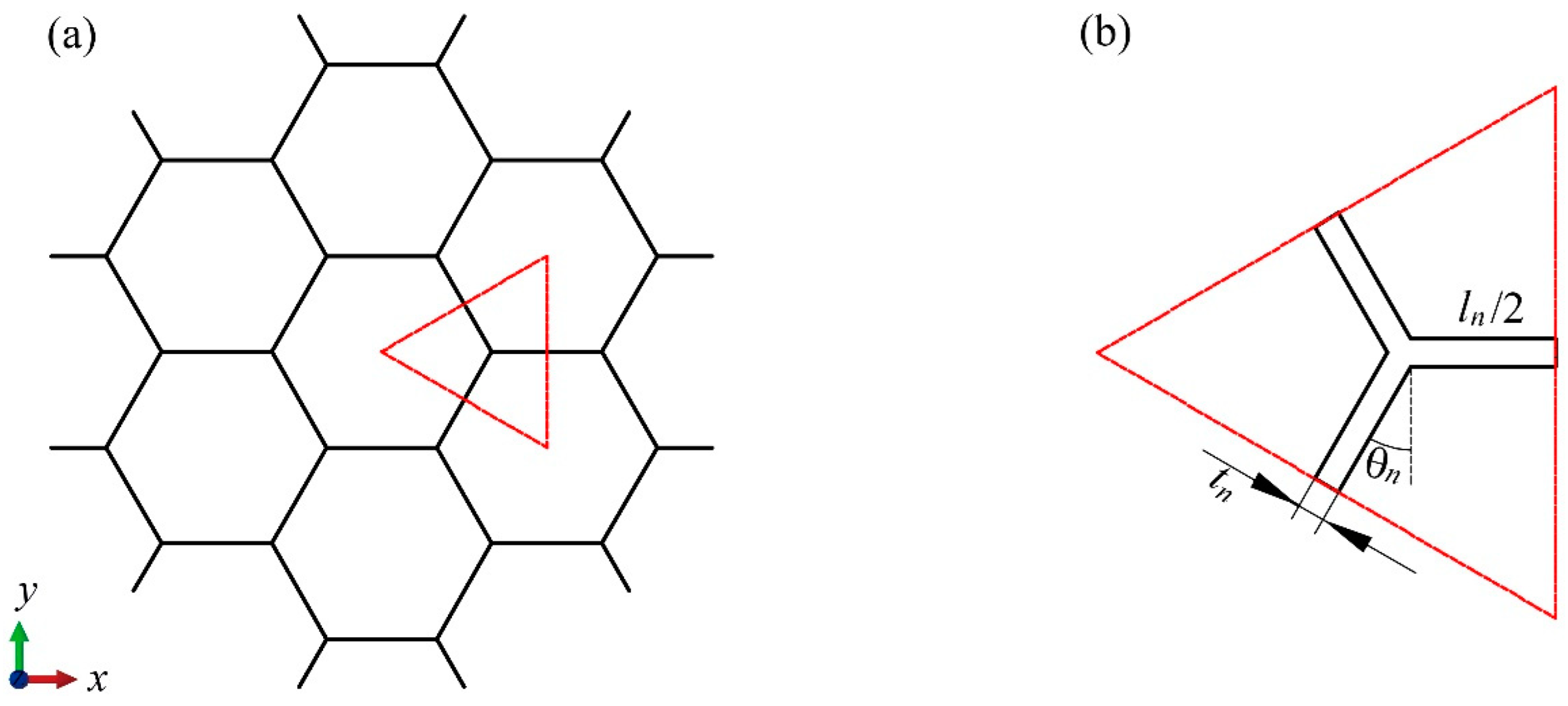
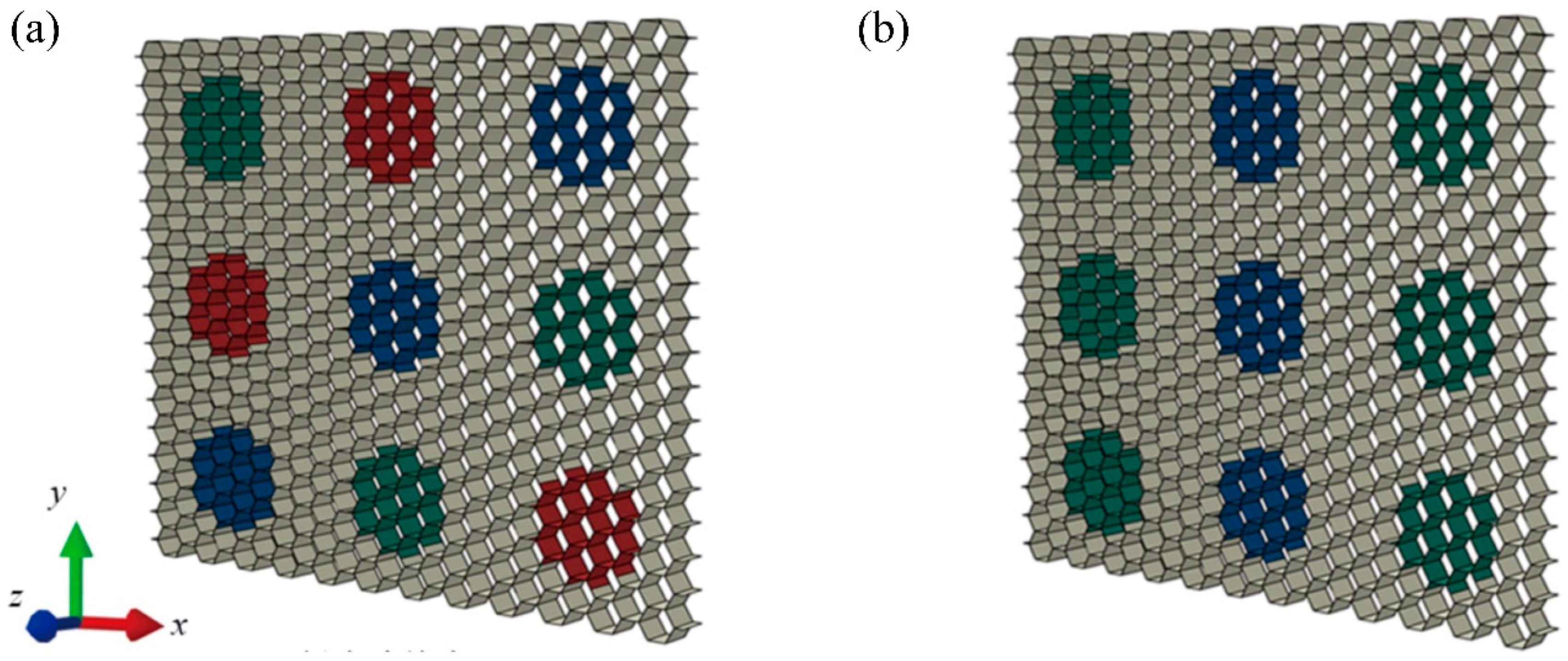
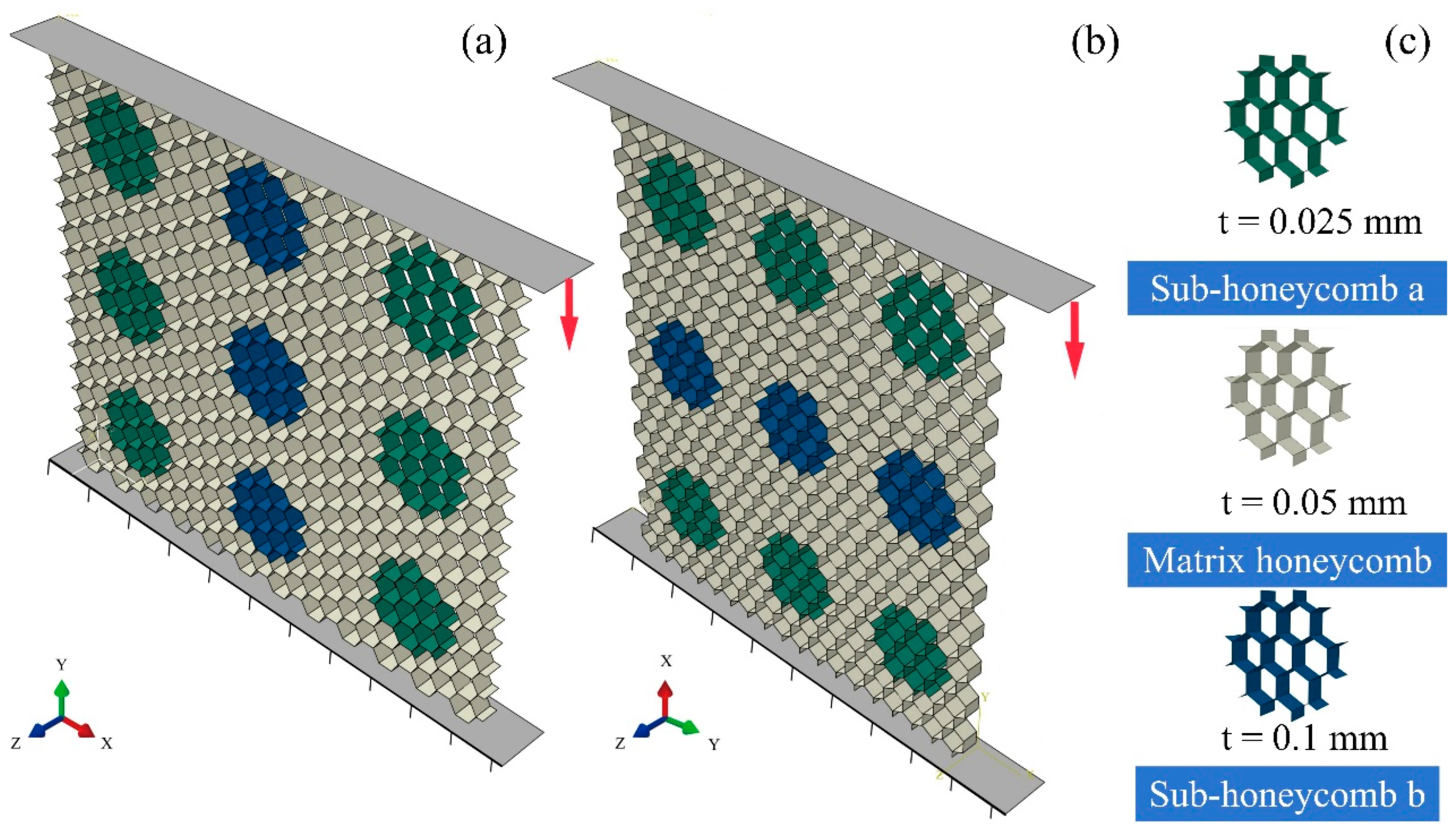


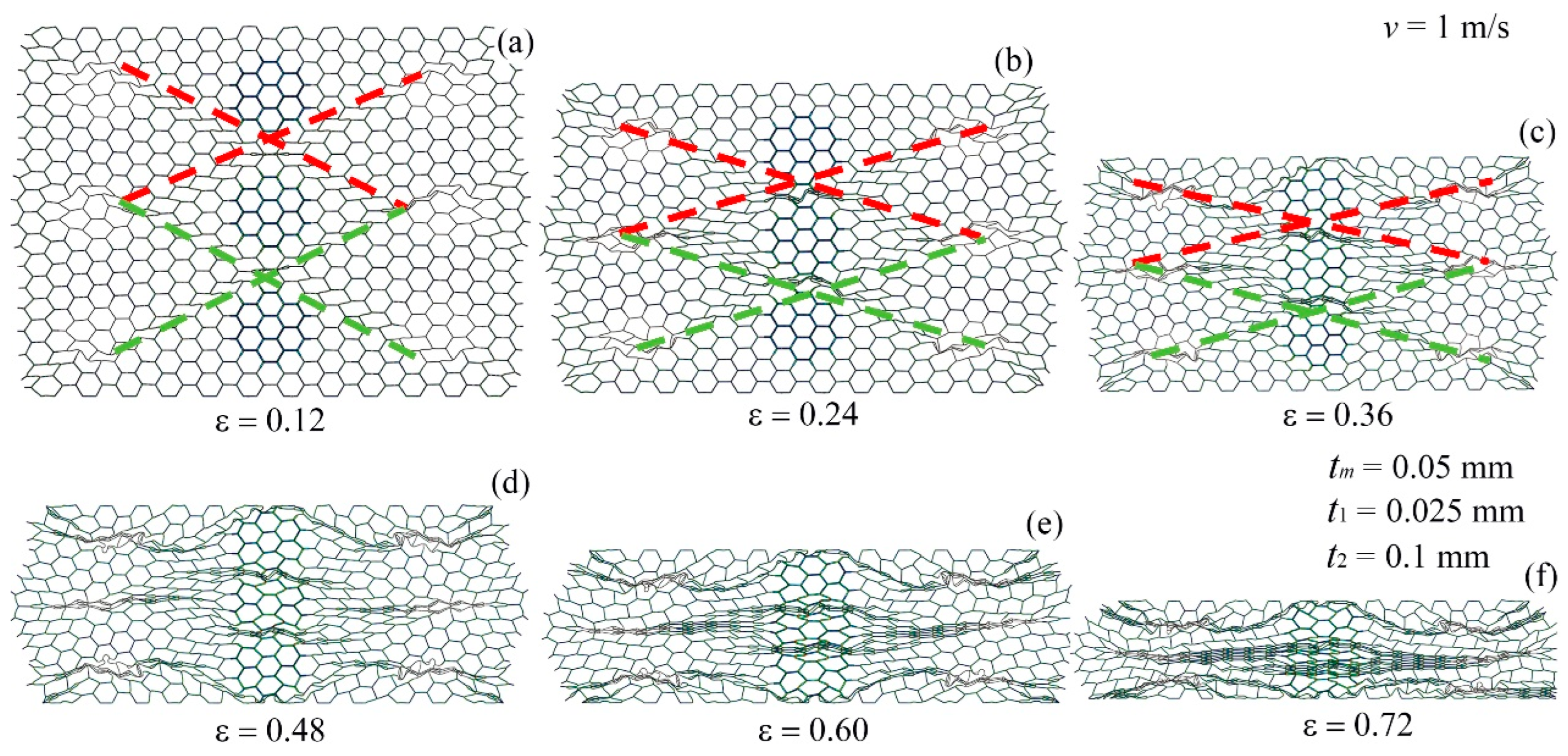
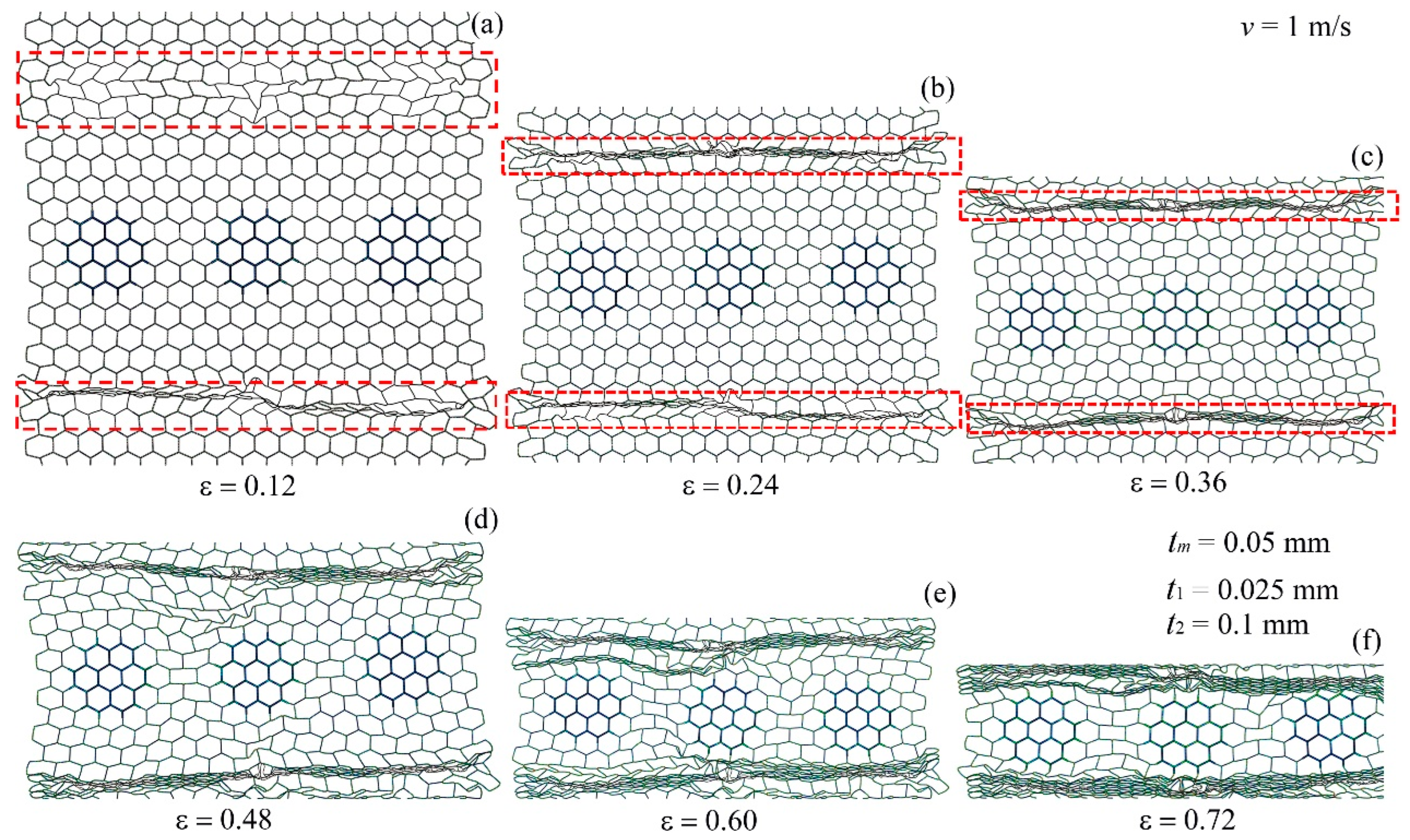



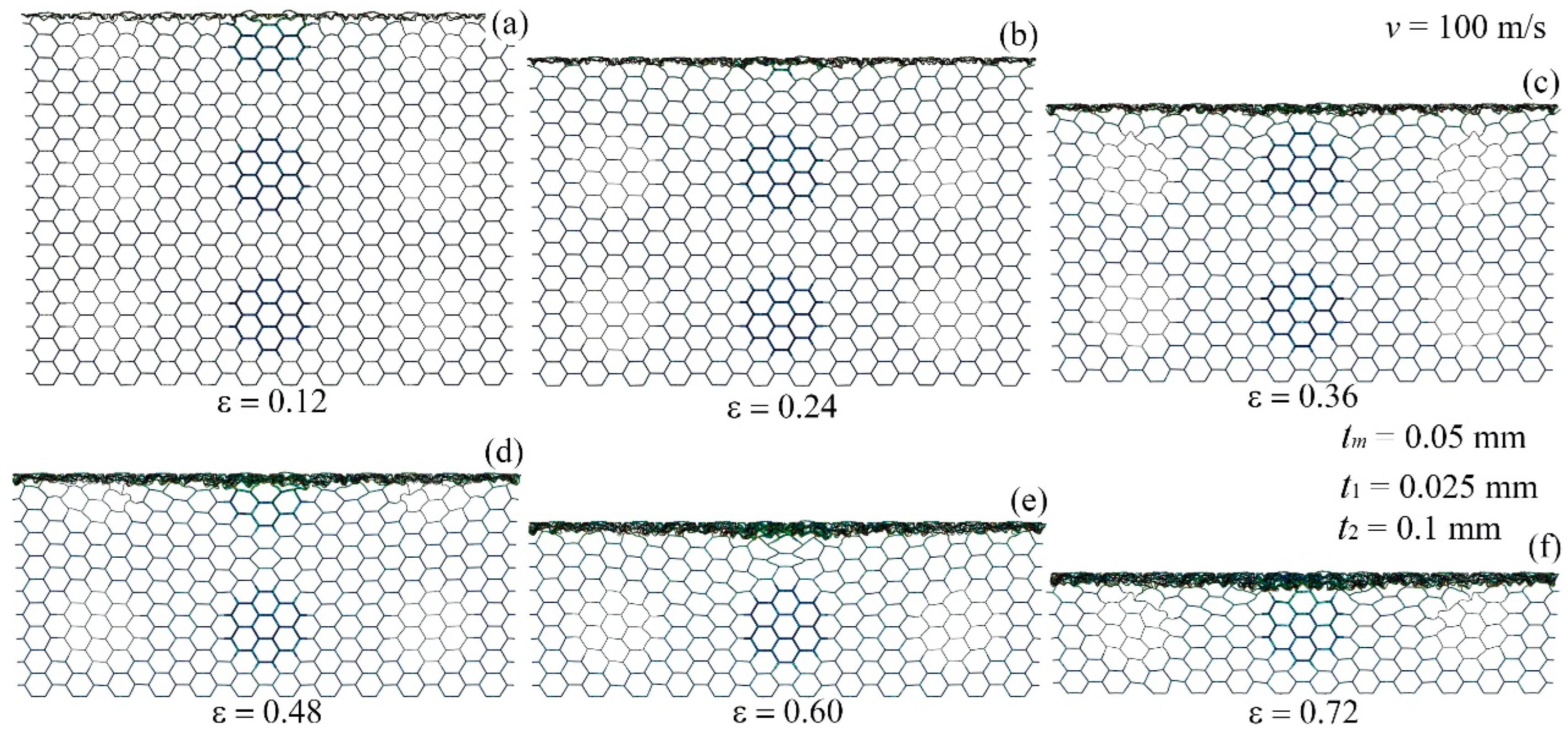
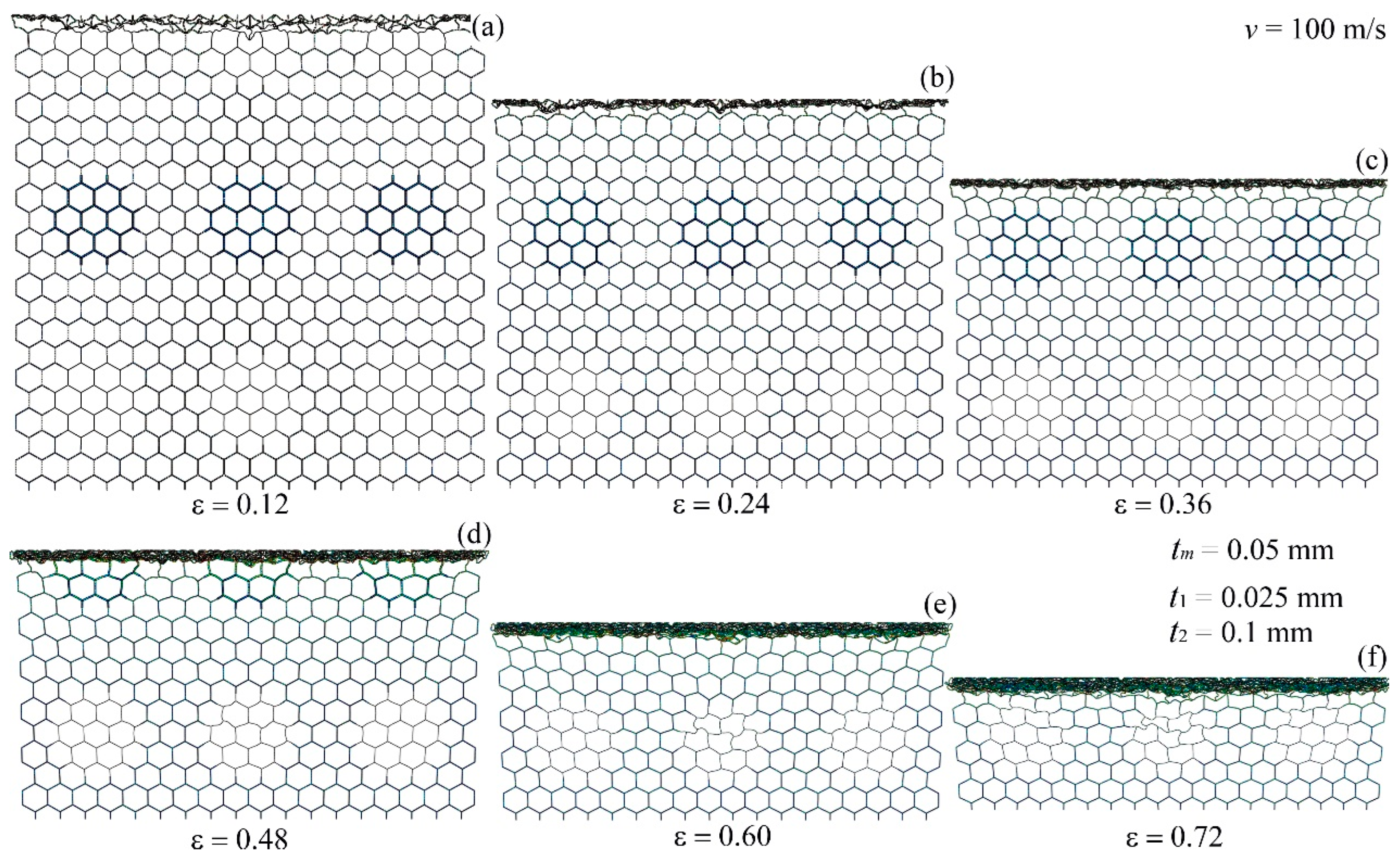

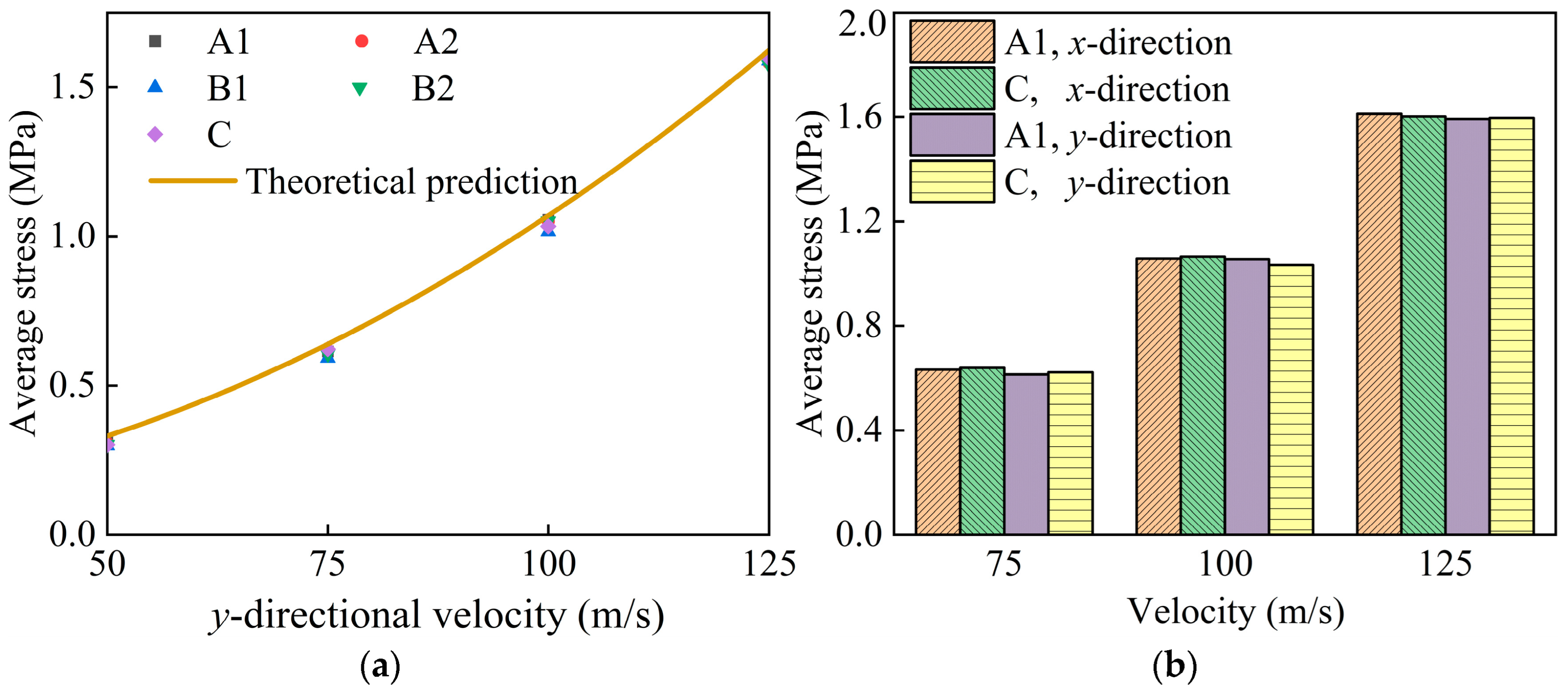


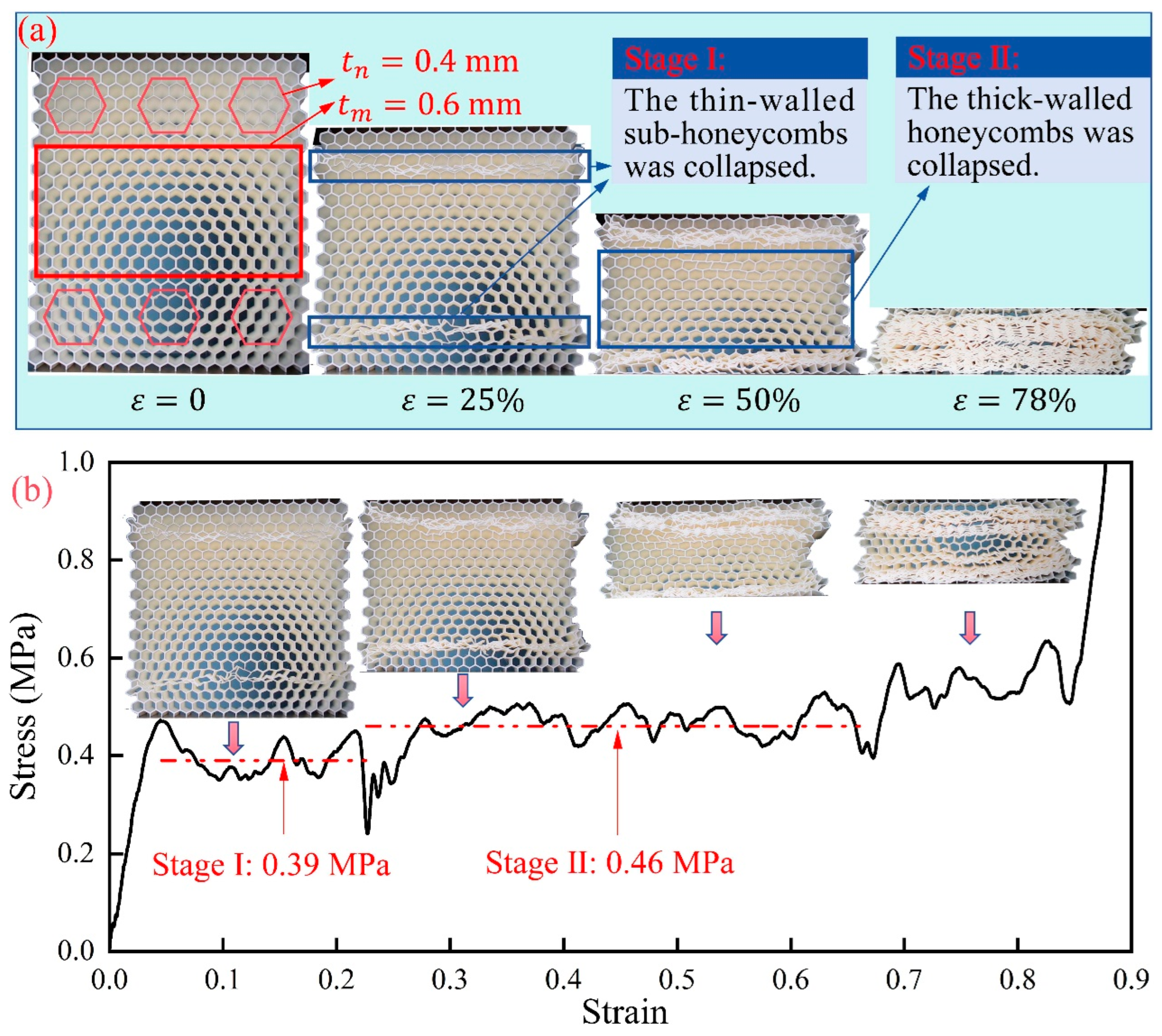
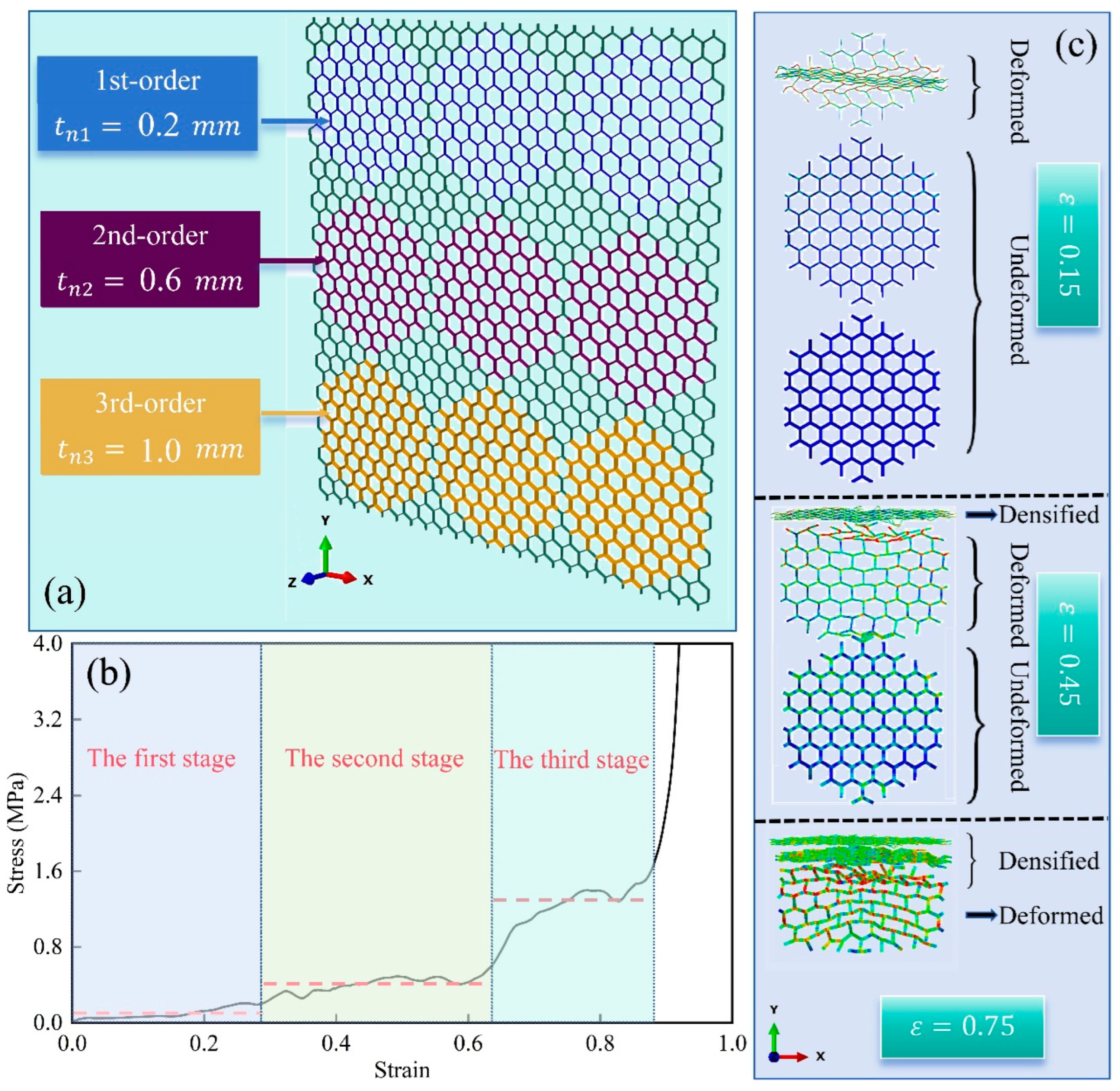
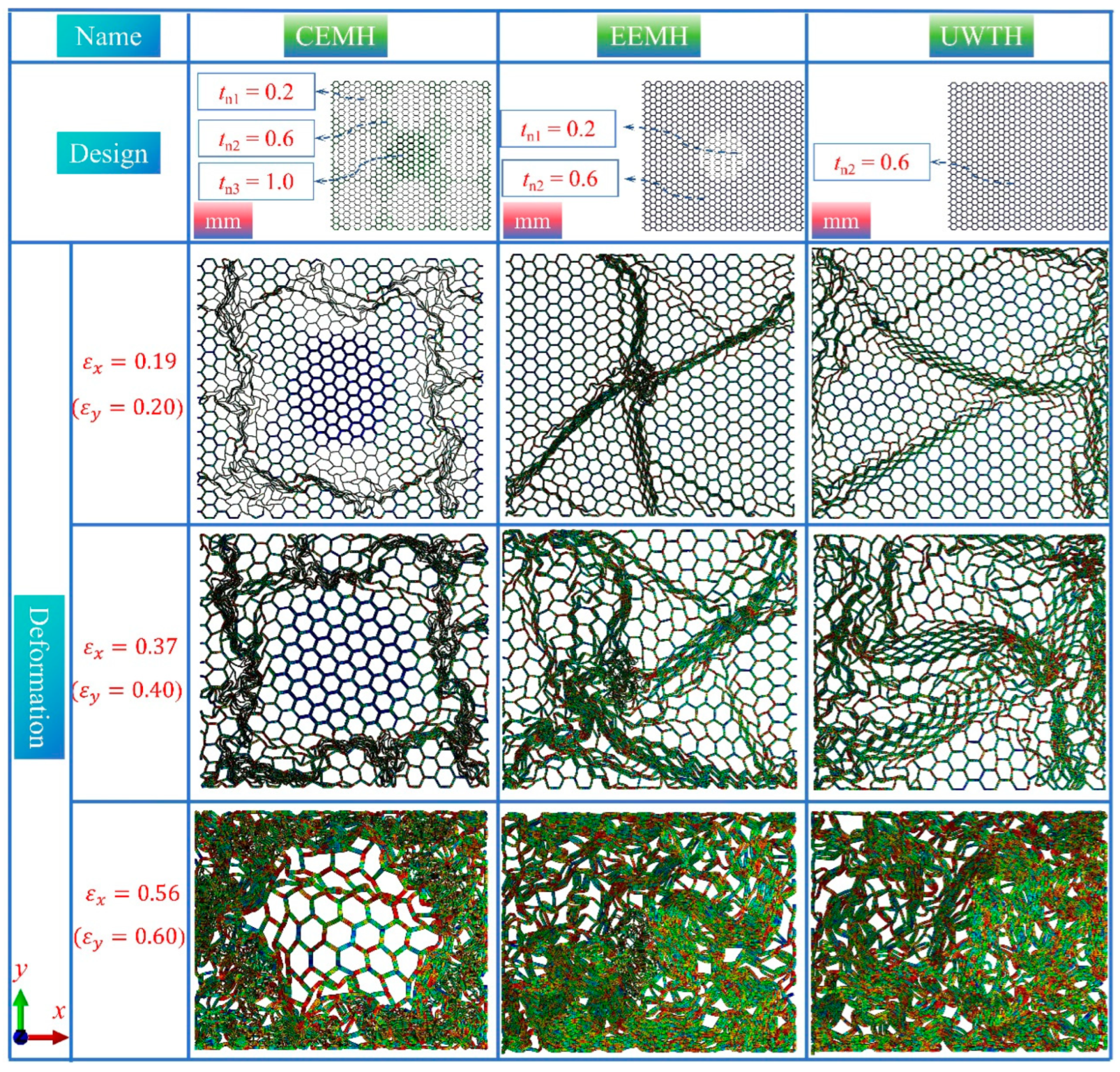
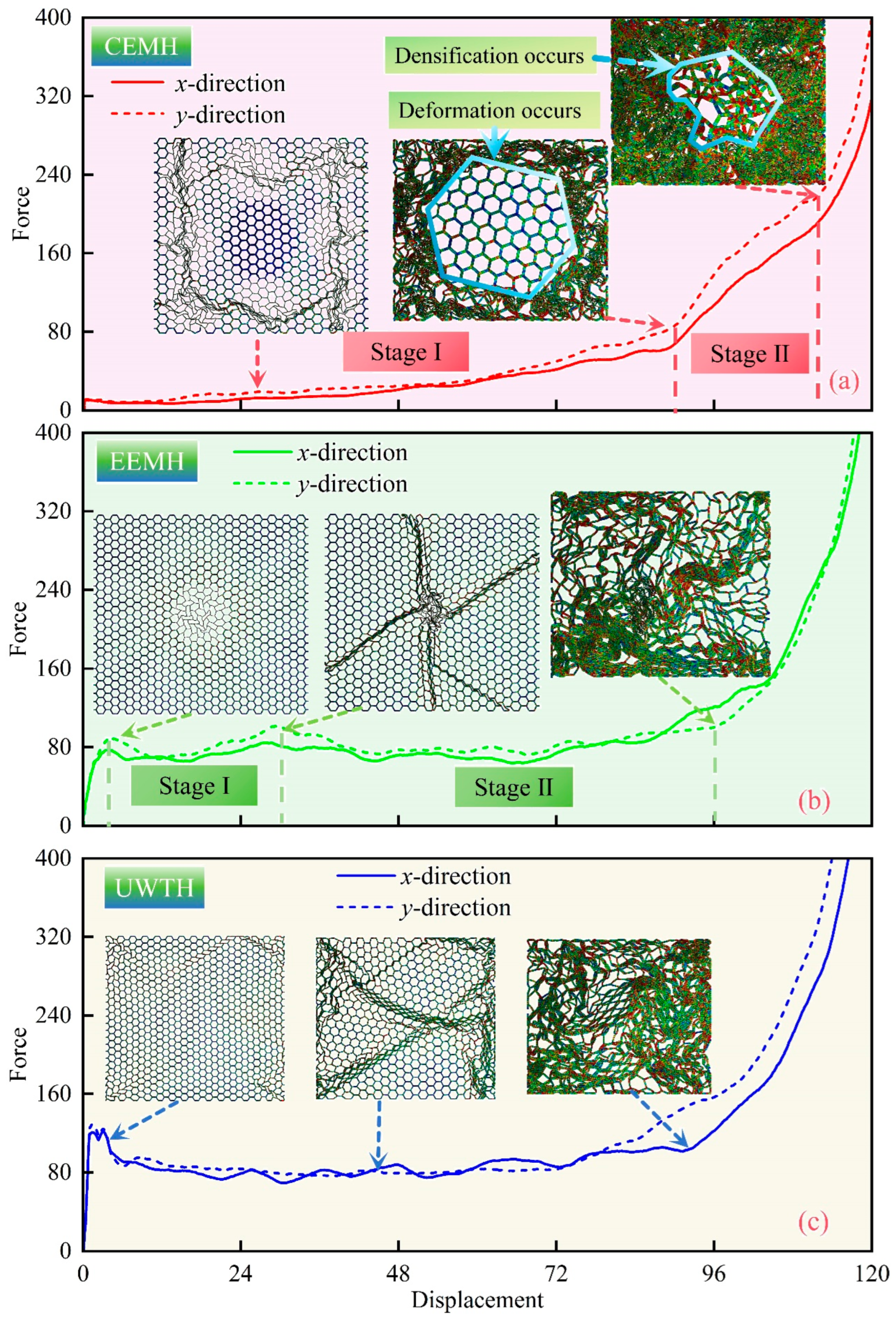
| Strain | Stress (MPa) | Strain | Stress (MPa) |
|---|---|---|---|
| 0 | 80.09 | 0.094 | 174.01 |
| 0.024 | 117.95 | 0.116 | 188.12 |
| 0.048 | 146.09 | 0.138 | 196.91 |
| 0.071 | 161.43 | 0.160 | 203.54 |
| Group | Types | Sub-Honeycomb a (mm) | Sub-Honeycomb b (mm) | Matrix Honeycomb (mm) | Relative Density |
|---|---|---|---|---|---|
| A | A1 | 0.09 | 0.18 | 0.12 | 3.46% |
| A2 | 0.15 | 0.06 | 0.12 | 3.46% | |
| B | B1 | 0.18 | 0.27 | 0.09 | 3.46% |
| B2 | 0.05 | 0.08 | 0.14 | 3.46% | |
| C | C1 | 0.12 | 0.12 | 0.12 | 3.46% |
| Velocity | 1 m/s | 10 m/s | 30 m/s | 50 m/s | |
|---|---|---|---|---|---|
| Type | |||||
| A1 | 0.84 | 0.85 | 0.86 | 0.88 | |
| A2 | 0.84 | 0.86 | 0.86 | 0.90 | |
| B1 | 0.85 | 0.87 | 0.87 | 0.87 | |
| B2 | 0.87 | 0.88 | 0.88 | 0.89 | |
| C | 0.86 | 0.86 | 0.87 | 0.90 | |
| Maximum difference | 2.33% | 2.33% | 1.15% | 3.33% | |
Disclaimer/Publisher’s Note: The statements, opinions and data contained in all publications are solely those of the individual author(s) and contributor(s) and not of MDPI and/or the editor(s). MDPI and/or the editor(s) disclaim responsibility for any injury to people or property resulting from any ideas, methods, instructions or products referred to in the content. |
© 2024 by the authors. Licensee MDPI, Basel, Switzerland. This article is an open access article distributed under the terms and conditions of the Creative Commons Attribution (CC BY) license (https://creativecommons.org/licenses/by/4.0/).
Share and Cite
Shen, L.; Wu, Y.; Ye, T.; Gao, T.; Zheng, S.; Long, Z.; Ren, X.; Zhang, H.; Huang, J.; Liu, K. Biomimetic Modular Honeycomb with Enhanced Crushing Strength and Flexible Customizability. Materials 2024, 17, 4950. https://doi.org/10.3390/ma17204950
Shen L, Wu Y, Ye T, Gao T, Zheng S, Long Z, Ren X, Zhang H, Huang J, Liu K. Biomimetic Modular Honeycomb with Enhanced Crushing Strength and Flexible Customizability. Materials. 2024; 17(20):4950. https://doi.org/10.3390/ma17204950
Chicago/Turabian StyleShen, Lumin, Yuanzhi Wu, Tuo Ye, Tianyu Gao, Shanmei Zheng, Zhihao Long, Xi Ren, Huangyou Zhang, Junwen Huang, and Kai Liu. 2024. "Biomimetic Modular Honeycomb with Enhanced Crushing Strength and Flexible Customizability" Materials 17, no. 20: 4950. https://doi.org/10.3390/ma17204950
APA StyleShen, L., Wu, Y., Ye, T., Gao, T., Zheng, S., Long, Z., Ren, X., Zhang, H., Huang, J., & Liu, K. (2024). Biomimetic Modular Honeycomb with Enhanced Crushing Strength and Flexible Customizability. Materials, 17(20), 4950. https://doi.org/10.3390/ma17204950






